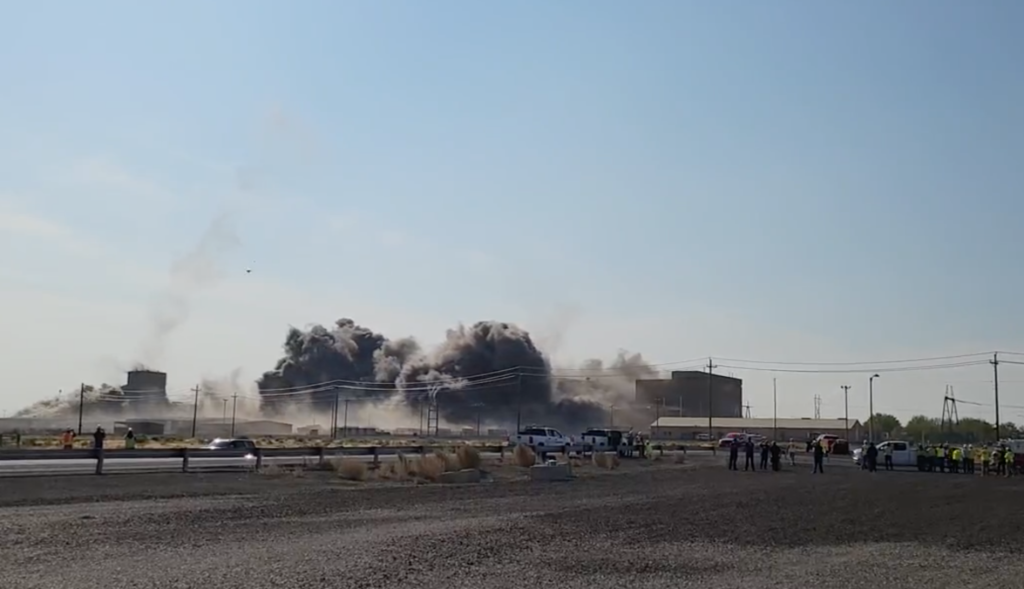Portland General Electric takes down Boardman coal-fired plant, last of its kind in Oregon
Published 10:00 am Friday, September 16, 2022

- Dust and smoke rise Thursday, Sept. 15, 2022, after a demolition contractor imploded Portland General Electric’s decommissioned coal-fired power plant near Boardman. The facility was the last coal-burning power generator in Oregon.
BOARDMAN — The last coal-fired power plant in Oregon is no more.
Trending
The plant and its towering coal stack about 11 miles from Boardman came crashing down Thursday morning, Sept. 15, before a crowd of former employees and local officials.
Portland General Electric began operating the plant in 1980. It produced power for around 500,000 homes in Oregon. A demolition team at 10 a.m. took down the 656-foot-tall stack and boiler structure two years after PGE closed down its operation.
“This plant has created a legacy, not just because of the plant, but because of the people here in Boardman,” Brad Jenkins, vice president of Utility Operations for PGE told the crowd before the big moment.
Trending
PGE hired Jenkins at the Boardman plant in 2012, and he became the plant manager for a time. He explained this was an emotional day for him because the plant was more than the sum of its parts but rather a community.
“We had great community partners in Boardman, we had transmission, a source of water, any power plant you need these few things.” Jenkins said.
Morrow County Commissioner Don Russel also spoke. He took a moment to thank the hardworking community for its contribution to the plant and to powering Oregon at large.
“For decades, the Boardman plant provided not just reliable power, but also living wage jobs, learning opportunities and a community atmosphere for its employees,” Russell said. “PGE employees have been great contributors to our community and have filled vital roles that make our community a community. We’ve had a couple of mayors that were PGE employees, city counselors, planning commissioners, directors of our local chamber of commerce, coaches of all levels and all sports, Boy Scout leaders and also many other roles that make our community a livable place.”
As opening remarks came to a close, Jessika Killgore, a former intern at the Boardman plant, and the safety officer overseeing the crowd observing the demolition, handed our ear plugs and advised attendees to crack open their car windows to prevent shock waves from destroying the glass.
“I wasn’t there very long, I was an intern for a few summers. I worked in our store rooms. I did inventory, we had seven store rooms, it put me through college,” Killgore said. “My great grandpa helped build it, my grandpa, my dad, and my brother worked there as well. It was a family business.”
From past to the future
Jenkins said the demolition of the Boardman plant represents one more step in PGE’s state-wide energy transition, moving away from energy sources that produce greenhouse gasses and firmly into the realm of renewable energy.
PGE executives decided more than a decade ago to shut the Boardman plant down by 2020 when the economic and environmental outlook for coal power darkened. The announcement helped settle a Clean Air Act lawsuit environmental groups brought, plus PGE avoided having to make costly emissions control upgrades down the road.
The closure eliminated about 2 million tons of greenhouse gas emissions that were coming from the plant every year. (That amount of carbon dioxide equals the annual pollution from about 431,000 passenger cars in average use, according to the Environmental Protection Agency’s greenhouse gas calculator.) The closure also ended mercury and sulfur dioxide emissions that contributed to air pollution in the surrounding area and the Gorge scenic area.
PGE worked to determine whether it could convert the Boardman facility into a more environmentally friendly operation, but after testing multiple methods of conversion, it was deemed inefficient, Jenkins explained.
“We looked at conversion to natural gas, which is a very simple conversion, but it’s not nearly as efficient as neighboring purpose-built plants,” he said. “We looked at carbon capture, but carbon capture technology right now isn’t evolved enough. It will evolve, much like hydrogen, small nuclear reactors. Carbon capture will eventually become a player.”
Efforts to convert the Boardman plant went so far as to siphon carbon from the plants smoke stack, and feed it to algae ponds in an effort to stimulate algae growth, for eventual use as a biofuel.
“We’ve worked a lot with stakeholders trying to get some technology that would work and allow the plan to run,” Jenkins said, “but at the end of the day, you still have a carbon footprint.”
The demolition also shifts PGE’s focus to Wheatridge, a first-of-its kind wind, solar and storage battery complex about 30 miles away in central Morrow County. Wheatridge became fully operations earlier this year.
“By 2040, the power PGE serves its customers will be greenhouse gas emissions free as we work with our partners across the state to lead the way when it comes to the clean energy transition,” Jenkins said. “You see the shift in our journey to transition, coal was just a part of that journey. The coal plant has been the workhorse of the fleet for 40 years, but if you look around the landscape here we’ve got a lot of clean renewable energy sources coming in. We’re transitioning and this is just a part of that transition.”
— Oregon Public Broadcasting contributed to this report.









